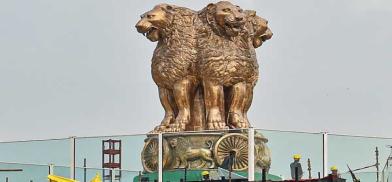National emblem: What is the image that a modern India wants to project?
It must be noted that tolerance, acceptability and confidence form a nation’s basic tenets. Aggression, violence and intolerance stall its progress and development, write Abhinav Mehrotra and Dr Biswanath Gupta for South Asia Monitor

The national emblem cast on the roof of the new Parliament building has sparked criticism, with the opposition and a section of vigilant citizens accusing the government of distorting the iconic symbol. The national emblem, adopted by the Republic of India on January 26, 1950, was modeled on the Lion Capital erected by Emperor Ashoka during 250 BC at Sarnath now in Uttar Pradesh. The three-dimensional sculpture carved from a block of sandstone features four Asiatic lions standing back-to-back, on an elaborate circular base of lotus in full bloom, and includes other animals such as a horse, a bull and an elephant along with a Dharma Chakra at its center.
Along with the symbol, a motto, “Satyameva Jayate” (Truth Alone Triumphs), was adopted from the Hindu Mundaka Upanishad. Through this sculpture, Emperor Ashoka wanted to capture the essence of Buddhism which he embraced after witnessing the bloodshed unleashed by his wars of conquest. Thereafter, the doctrines of Buddhism such as non-violence, spiritualism, compassion and peaceful co-existence symbolized by the sculpture formed the bedrock of his administration.
The lion emblem, one of the distinctive symbols of national identity, captures the spirit of the nation. The four Asiatic lions with their graceful posture represent the power, confidence, courage and pride of the nation. The galloping horse carved on the left of the Dharma Chakra stands for loyalty, speed and energy. The bull on the right symbolizes hard work and steadfastness. The lotus stands for creation, spirituality and illumination. The Dharma Chakra, one of the auspicious symbols of Buddhism, represents the pan-India concept of Dharma -- meaning righteousness, merit and religious and moral duties governing individual conduct and adhered to by Indic religions such as Hinduism, Sikhism, Jainism and others.
New icon
The unveiling of the 6.5 metre tall and 9,500 kg heavy bronze emblem by Prime Minister Narendra Modi on July 11 ignited a political row. The opposition alleged that the character and nature of the Asiatic lions have been modified, thereby desecrating our national symbol. The iconic look of gentleness and serenity represented by the Ashoka lions was replaced by a menacing and aggressive posture.
The angry lions with bared fangs etched in the new emblem violate the ideals of tolerance, pluralism and non-violence upheld by nationalist rhetoric. This may hamper the image of the country at the global level, where it has worked towards ensuring peace and security and followed the principle “Vasudev Kutumbakam“ -- which means the world is one family – in its outlook to the world.
The controversy over the facial expressions of the lions may have been shaped by the angle of photography of the emblem might. Sculptor Sunil Deore clarified that the ground level view, low angle photography and difference in height have influenced the changed perspective of viewers.
New India?
Supporters of the new posture claim that the muscular and snarling demeanour of the lions represent the aggressive quotient of a “New India” which strongly asserts its presence in the international arena and bravely pursues its interests. Rapid economic expansion, military capabilities and success of its strategic interests have added this new aggressive quotient to India’s diplomacy.
But critics claim that the policy of tolerance, non-violence, calmness and confidence form the bedrock of Indian culture since time immemorial. They argue that the legacy of 5,000 years of India’s civilization is accommodative as it has assimilated all the different religions and cultures as its own. It must be noted that tolerance, acceptability and confidence form a nation’s basic tenets.
Aggression, violence and intolerance stall its development and progress. The changed outlook of the nation as reflected in the angry lions with bared fangs might tarnish its traditional image of being a liberal and tolerant nation.
(Abhinav Mehrotra is Assistant Professor at O.P. Jindal Global University, Sonipat, India. He can be contacted at amehrotra@jgu.edu.in. Dr. Biswanath Gupta is Associate Professor at the O.P. Jindal Global University. He can be contacted at bgupta@jgu.edu.in. Anindita Dutta is a research scholar pursuing her PhD in English Literature from Tezpur University. Views are personal.)









Post a Comment